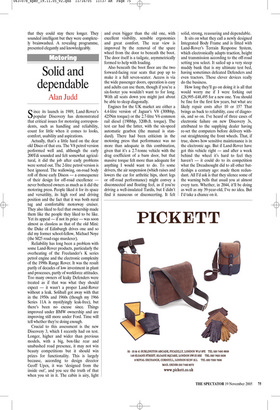Solid and dependable
Alan Judd
Sce its launch in 1989, Land-Rover’s inpopular Discovery has demonstrated that critical issues for motoring correspondents, such as handling and reliability, count for little when it comes to looks, comfort, usability and aspirations.
Actually, that’s a little hard on the dear old Disco of that era. The V8 petrol version performed well and, although the early 200Tdi sounded and felt somewhat agricultural, it did the job after early problems were sorted out. The 2-litre petrol version is best ignored. The wallowing, on-road body roll of those early Discos — a consequence of their design for off-road excellence never bothered owners as much as it did the motoring press. People liked it for its space and versatility, its high roof and driving position and the fact that it was both rural tug and comfortable motorway cruiser. They also liked to feel that ownership made them like the people they liked to be like. Yet its appeal — if not its price — was soon almost as classless as that of the old Mini: the Duke of Edinburgh drives one and so did my former school-fellow, Michael Noye (the M25 road-rage murderer).
Reliability has long been a problem with some Land-Rover products, particularly the overheating of the Freelander’s K series petrol engine and the electronic complexity of the 1990s Range Rover. It was the result partly of decades of low investment in plant and processes, partly of workforce attitudes. Too many owners of leaky Defenders were treated as if that was what they should expect — it wasn’t a proper Land-Rover without a leak. Solihull got away with that in the 1950s and 1960s (though my 1966 Series 11A is mystifyingly leak-free), but there’s been no excuse since. Things improved under BMW ownership and are improving still more under Ford. Time will tell whether they’re doing enough.
Crucial to this assessment is the new Discovery 3, which I recently had on test. Longer, higher and wider than previous models, with a big, box-like rear and unabashed road presence, it may not win beauty competitions but it should win prizes for functionality. This is largely because, according to design director Geoff Upex, it was ‘designed from the inside out’, and you see the truth of that when you sit in it. The cabin is airy, light and even bigger than the old one, with excellent visibility, sensible ergonomics and great comfort. The rear view is improved by the removal of the spare wheel from the door to beneath the boot. The door itself is a tailgate, asymmetrically formed to help with loading.
Also beneath the boot floor are the two forward-facing rear seats that pop up to make it a full seven-seater. Access is via the wide passenger doors, operation is easy and adults can use them, though if you’re a six-footer you wouldn’t want to for long. With all seats down you might just about be able to sleep diagonally.
Engines for the UK market are either a 4.4-litre version of Jaguar’s V8 (300bhp, 425Nm torque) or the 2.7-litre V6 common rail diesel (190bhp, 320lb.ft. torque). The test car had the latter, with the six-speed automatic gearbox (the manual is standard). There had been criticism in the motoring press that performance was no more than adequate in this combination, given that it’s a 2.7-tonne vehicle with the drag coefficient of a barn door, but that massive torque felt more than adequate for anything I would want to do. To some drivers, the air suspension (which raises and lowers the car for arthritic hips, short legs or off-road performance) might convey a disconnected and floating feel, as if you’re driving a well-insulated Tardis, but I didn’t find it nauseous or disconcerting. It felt solid, strong, reassuring and dependable.
It sits on what they call a newly designed Integrated Body Frame and is fitted with Land-Rover’s Terrain Response System, which electronically adapts traction, height and transmission according to the off-road setting you select. It sailed up a very steep muddy bank that is my ultimate test bed, having sometimes defeated Defenders and even tractors. These clever devices really do the business.
How long they’ll go on doing it is all that would worry me if I were forking out £26,995–£48,495 for a new one. You should be fine for the first few years, but what are likely repair costs after 10 or 15? That brings us back to reliability, ease of diagnosis, and so on. I’ve heard of three cases of electronic failure on new Discovery 3s, attributed to the supplying dealer having re-set the computers before delivery without straightening the front wheels. That, if true, shows how sensitive maintenance is in the electronic age. But if Land-Rover have got this vehicle right — and after a week behind the wheel it’s hard to feel they haven’t — it could do to its competition what the Dreadnought did to all other battleships a century ago: made them redundant. All I’d ask is that they silence some of the warning bells that assail you at almost every turn. Whether, in 2044, it’ll be doing as well as my 39-year-old, I’ve no idea. But I’d take a chance on it.

























































 Previous page
Previous page